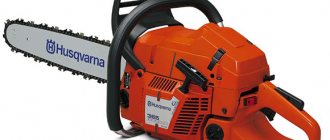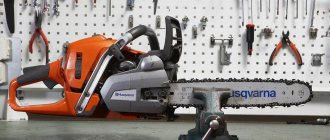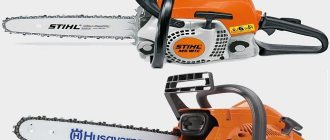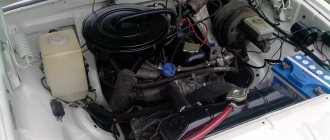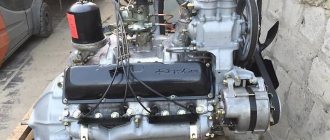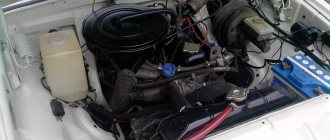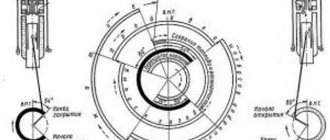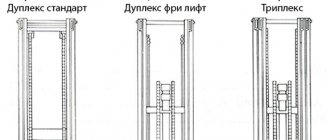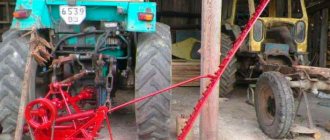Preparing and starting the saw
The handle that controls the throttle, simply called the gas button, is located on the back of the handle.
To avoid accidentally starting the engine, when pressing the gas button, you need to release the lever - the throttle lock, located on top of the handle. There is a chain catcher located at the bottom of the saw; in the event of a chain break, it catches it, protecting the operator from serious injury. Using the stop button, also called the ignition, you can quickly turn off the engine; it is located in a convenient place. The chain brake handle can be activated in two different ways. Method number one is manual, you only need to push the brake handle forward, the second method is inertial, in case of a reverse impact during a rebound. You will need to make sure that the chain is properly tensioned so that it is not too tight, but also does not hang from the tire. The newly put on chain needs to be tightened after operating the chainsaw for some time.
When starting the chainsaw engine, place it on a flat surface; the area under the tire should be cleared of foreign small objects. Having set the chain brake to the ON position, move the inertia brake handle forward and press the “smart start” button, if this function is present. When starting an unheated, cold engine, always close the air damper completely by pulling the regulator towards you.
The right foot steps with its toe on the bottom of the rear handle. Holding the upper handle with your left hand, with sharp but moderately strong movements we pull the starter cord by the handle, and continue until the engine shows the first signs of starting. Now the damper needs to be fully opened by pushing in the regulator. We continue to pull out the starter cord. It will be enough to make two or three jerks for the saw to start. Press the gas button once, after which the engine should stop idling.
To start a running and warm engine, there is no need to use a choke. All other moments when starting the saw will be exactly the same. It happens that it is difficult to start the saw even on a well-heated engine; you need to pull out the regulator all the way, just as you did when you started a cold engine, but then immediately push it back.
After starting the chainsaw engine, you do not need to remove the chain from the handbrake until you start working
It will be important to check the chain for lubrication. You will need to use some kind of light plane, be it a stump, paper or a light rag. We increase the chain speed a little, a path of engine oil is formed, which will indicate a sufficient oil level in the saw tank
We increase the chain speed a little, a path of engine oil is formed, which will indicate a sufficient oil level in the saw tank.
Try to hold the chainsaw firmly with both hands, all fingers should completely cover both handles. To minimize the force of kickback, the left hand should completely wrap around the foregrip with the thumb pointing straight down. You should never be afraid of the saw; the closer you hold it to your body, the less you will feel the actual weight of the saw. Better balance and control of the instrument will be maintained.
When moving from one place of work to another, you need to be sure that the chain is in a stationary position. To do this, always apply the chain brake, or better yet, stop the engine. When moving over even longer distances, put a protective cover on the bar, this will protect you from accidental injury and help protect the chain itself. After finishing work, it is recommended to drain the gas mixture and store the chainsaw with a dry tank.
It is important not to forget that the gasoline mixture is prepared for 7 to 10 days of maximum use. The mixture has its own shelf life and after 7 - 10 days it loses its properties. Chainsaws differ slightly in design features, but in most cases the assembly principle follows two standard schemes
For many devices, the instructions contain information about the need to activate the emergency brake before starting the switching procedure
Chainsaws differ slightly in design features, but in most cases the assembly principle follows two standard schemes. For many devices, the instructions contain information about the need to activate the emergency brake before starting the startup procedure.
You must first master the structure of the plant and study the basic methods of correcting breakdowns, then a person will have the opportunity to fully operate the device.
Stihl 180 chainsaw has no spark
The main malfunction due to which the Stihl MS 180 chainsaw does not start may be the lack of a spark between the electrodes on the spark plug. Signs of this malfunction can be detected by unscrewing the spark plug and inspecting it. Having discovered during inspection that the spark plug is wet, you need to start looking for the reason for the lack of a spark on the spark plug.
Spark plug faulty
The first thing you need to do is check the performance of the spark plug.
This is quite easy to do. The spark plug is inserted into the cap of the high-voltage wire and pressed against the engine cylinder, after which the starter moves several times; if a spark is not observed between the electrodes of the spark plug, it means it is faulty or the ignition module is faulty.
In order to find out for sure that the problem is in the spark plug, you need to check a known good one in the same way. If a spark appears as a result of the test, then the problem has been found and to eliminate the problem, replace the saw spark plug with a new one.
Problems with the ignition coil
The ignition coil, also called a module, has a non-separable design, so it is very difficult to determine its functionality without a special tool. If a spark does not appear on the working spark plug, suspicions arise that the coil is to blame. But you shouldn’t immediately remove the old coil and run to the store; the problems may be of a slightly different nature.
There is no clearance between the flywheel and the ignition module
In some cases, the lack of a spark at the spark plug is due to an incorrect gap between the contacts of the ignition module or the flywheel. It may be larger, or it may not exist at all, and then scratches will be observed on the surface of the flywheel resulting from contact with the coil contacts.
It is possible to check and set the gap without having a special tool. To do this, you will need to remove the starter, loosen the two coil mounting screws, place a plate cut from a plastic bottle between the flywheel contacts and the ignition module, and tighten the module mounting screws.
If after such adjustment of the gaps a spark appears, everything is in order, you can continue working with the Shtil 180 chainsaw; if not, you need to re-inspect and check whether the flywheel touches the coil contacts again. Let's say as a result of the check it was discovered that after adjusting the gap, it was gone again. This means that the cause is most likely in the crankshaft bearings.
Defective crankshaft bearings
If the crankshaft bearings are defective, there is a slight play on it. You can check for play by shaking the flywheel of the Shtil 180 chainsaw from side to side. If there is play, it means that under the influence of its magnets, the flywheel is attracted to the contacts of the ignition coil, since play on the bearings allows it to do this and, as a result, the spark disappears.
Also because of this malfunction, the Stihl MS 180 does not develop speed, they seem to float, or simply do not reach maximum values.
Replacing crankshaft bearings
It is better to replace the crankshaft bearings in a specialized service center, since when replacing you will need to completely disassemble the Shtil 180 chainsaw and remove all its main components.
Without some experience or at least the skills to repair similar chainsaws, it will not be possible to replace the crankshaft bearings efficiently.
So, we figured out the lack of a spark, but what to do if there is a spark, but there is no answer to the question why the Shtil 180 chainsaw does not start. The reason may be hidden in the fuel system.
By the way, many buyers are wondering whether or not to take the 170 model, it is very similar to the 180, for more details, read the comparative article here.
How and when to adjust the ignition on a Husqvarna saw
Users of Husqvarna often have a question: how and when to adjust the ignition. The answer is simple. Husqvarna chainsaws have an electronic ignition coil and flywheel, which cannot be adjusted. The only thing that can be adjusted is the gap between the coil and the flywheel.
To adjust the gap at home, you need to cut a feeler gauge out of a plastic bottle, and then loosen the screws securing the coil. Next, the probe is installed between the coil contacts and the flywheel. The screws are tightened.
It is necessary to adjust the gap during maintenance or when scoring is detected on the surface of the flywheel. Such scuffs indicate that there is no gap at all.
If, after adjusting the gap between the coil and the flywheel, the parts continue to touch, then it is necessary to check the crankshaft bearings for wear. They may be very worn and require replacement.
Procedure for setting up the carburetor
First of all, you need to use screw L to “find” the highest speeds when there is no load (idling). Next, turn it counterclockwise a quarter turn.
If in this position the chain on the bar continues to move, you need to stop it using screw T.
To adjust the Husqvarna carburetor at maximum speed after pressing the accelerator button fully, wait 10-15 seconds. Turn screw “H” clockwise ¼ turn and listen to the operation of the internal combustion engine. If there is an extraneous loud “squeal” when the engine is running, gradually unscrew the bolt until it disappears. On the contrary, if there is excessive smoke emission, it is necessary to lean the mixture by gradually tightening the screw.
After setting the minimum and maximum speeds, we adjust the idle speed of the saw. To do this, tighten the “T” screw clockwise until the chain begins to move along the bar.
Correctly setting the fuel supply system requires a tachometer (a device for measuring revolutions per minute), as well as the owner’s experience.
READ Things Go Well When You Have a Chainsaw in Your Hands
Husqvarna chain features: design, tension
The cutting chain of saws from this manufacturer consists of working teeth, plunge depth limiters, and fixing pins. The most loaded parts during the sawing process are the cutting links made of high-alloy structural steel. By design, they are divided into left- and right-handed. The width of the cut is determined by the distance from the side edges of the left and right links.
DIY Husqvarna chain tension
The main characteristic of a chain for a Husqvarna chainsaw is the pitch, which can be measured from the first to the third rivet, dividing the result by two. Due to the fact that the Western calculation system uses the inch system, manufacturers indicate the pitch in inches (25.4 mm) in tool passports. For medium-power chainsaws, 3/8-inch chains are used, and for heavier-duty chainsaws, 4-inch chains are used.
One of the most important indicators of a chain is the thickness of the shank, which for most models is 1.3 mm. They are often used on specialized and ordinary amateur instruments. The thickness of the links must be consistent with the groove of the bar, since excessive thickness can lead to chain breakage or drop.
When the chain relaxes, it must be tightened using a mechanism located on the side of the unit. Having first removed the left side cover (2 bolts), loosen the bar for the Husqvarna chainsaw. Next, we unscrew the longitudinally twisted bolt, thereby moving the guide away from the power unit. When adjusted correctly, the chain should turn easily, but not dangle on the bar.
Starter
The starter is located on the right side of the Husqvarna and is held in place by several screws. By unscrewing them, you can easily remove the starter and thereby gain access to the flywheel and ignition coil.
Husqvarna 240 chainsaw malfunctions
The main causes of breakdowns of the popular model of the Swedish brand, as a rule, are improper operation or wear and tear of the main parts of the operating saw mechanisms. Most of the malfunctions of garden tools can be fixed independently, which can save a significant amount and time of the owner.
Why gasoline leaks - causes and troubleshooting
Arbitrary leakage of gasoline becomes a common cause of breakdown of the fuel tank or malfunction of the pump responsible for pumping fuel through the fuel pipes. If the cause of the breakdown lies in the pump, then it will need to be replaced, since the pump cannot be repaired.
You can fix a breakdown in the fuel tank yourself. If the hole is not large, then it can be treated with sealant. If the hole in the tank is too large, then the entire plastic tank will need to be replaced.
Advantages of the Husqvarna 240 chainsaw
- The model is equipped with an engine of the new X-TORQ technology. X. Therefore, the Husqvarna 240 is characterized by increased environmental friendliness due to reduced exhaust emissions. Also, the design of the engine allows for economical use of fuel, reducing its consumption.
- The built-in Air Injection air purification system reduces wear on tool filters.
- The vibration reduction system reduces the negative effects on the human body. The manufacturer moved the engine further away from where the handles were attached and installed mufflers.
- Convenient chain tension adjustment is located on the side of the tool.
- The inertia brake ensures safe use of the Husqvarna 240.
Among the disadvantages of the model, users note high oil consumption due to the mechanical pump. Also, the air filter should be made of more durable material.
To reduce fuel consumption, we recommend diluting the oil in a ratio of 1:50.
Features of the Husqvarna 240 chainsaw
The Husqvarna 240 chainsaw is a semi-professional tool. Well suited for sawing boards in the private sector or cutting branches in the garden.
The production and assembly of the car takes place in the USA. The tool comes with a two-year warranty.
Husqvarna 240 chainsaws have decent technical indicators:
- Two-stroke engine with a volume of 38.2 cm³ and a power of 1.5 kW.
- The fuel tank is 0.4 l and the oil tank is 0.2 l.
- The optimal tire length is 38 cm.
- High noise level, more than 100 dB.
- IIDA ignition system with 0.5 mm spark plug.
- 4.7 kg weight without saw accessories.
- 9 thousand cylinder revolutions per minute.
- Fixed flow oil pump.
The Husqvarna 240 saw comes with a bar and chain, a set of keys and a protective cover. And, of course, with the operating rules.
In addition to the chainsaw, you must purchase a sharpening set, two-stroke oil and chain oil.
Buy tools from authorized Husqvarna dealers.
General characteristics of chainsaws
Chainsaw. This is a portable, indispensable tool for cutting and sawing wood in private households.
Household machines are designed to operate 1 – 3 hours per day or 50 hours per month. Their design is simple and characterized by low weight and low power. A good choice for occasional work.
Professional models can withstand heavy loads and 8 hours of continuous operation. Their power starts from 2.5 kW and 9 thousand / min. chain revolutions. Used in forestry and industrial production.
The intermediate link is semi-professional chainsaws. They are a reliable assistant both in repairing and felling trees. A universal choice for systematic use. The saws have good power, but are designed to work 3 – 4 hours a day.
When choosing a chainsaw, you need to decide on the tasks it will perform. And choose the model required in terms of power. Then she will serve on the farm for many years.
What fuel should I use for my chainsaw?
Choosing the right fuel is an important and significant issue. The only correct approach to solving it is to carefully study the user manual, which indicates the type and brand of fuel, the mixing proportions of gasoline and oil, and also reflects all the features of this tool. Modern standards require the use of high-octane refined fuel and special types of motor oil.
Storage conditions for the finished mixture
Most users usually prepare the fuel mixture for future use. This is explained by saving time - it is believed that it is more correct to mix a large volume once, and then simply add fuel to the instrument tank. This point of view is acceptable, but with important limitations. The finished mixture cannot be stored for too long, as irreversible changes occur in it.
Ideally, you should prepare it for only one day, but this is considered by many to be too irrational. The permissible shelf life depends on the ratio and brand of components. Most experts recommend not storing the mixture for more than 3 months. It is recommended to use metal cans and keep the mixture under cover, away from direct sunlight.
How to remove and replace the drive sprocket
The chain moves along the bus by a drive sprocket, which is connected to the gearbox. It is an assembly unit that rotates due to a bearing. At the end of the tire there is a driven sprocket with the same pitch relative to the drive one. Therefore, when carrying out repair work, all factors are taken into account: the alignment of the splines, the presence of bearings, and the kinematics of the tool.
When the spline wears out, the drive sprocket is replaced, otherwise traction with the chain will not occur.
In order to change a part, you must perform the following steps:
- unscrew the nuts of the tire cover and remove the headset using working tools;
- remove the air filter;
- unscrew the saw spark plug;
- remove the clutch on the chainsaw;
- inspect the drum and check the crown;
- remove the chainsaw sprocket;
- if necessary, replace the broken part with a new one;
- Reassemble all parts in reverse order.
If the process of replacing a sprocket on a Husqvarna chainsaw is difficult, use the services of a specialist.
Features of the chainsaw device
A chainsaw is a chain hand tool, the cutting part of which is driven by a carburetor engine.
As a rule, this is a single-cylinder two-stroke engine.
This design is simple, economical, and can work in any position.
The structure of the saw, in addition to the engine, includes:
- carburetor;
- tire;
- cutting organ (chain);
- starter;
- centrifugal type clutch;
- ignition, fuel supply system, air filters;
- chain lubrication system;
- muffler;
- handles.
The motor can be positioned vertically (powerful, heavy-duty professional models) or horizontally (lightweight household tools). Heavy saws are used for felling and bucking trunks and have a large frame size. Light saws are used for cutting branches or sawing firewood; they are usually owned by private home owners, farmers, gardeners, etc.
The design of the tool is simple, which guarantees high strength and reliability. The engine shaft, through the clutch, drives the drive sprocket, which moves the chain along the bar with the help of the drive sprocket. A two-stroke engine does not require a camshaft, valve system and other elements, which also helps to increase the reliability of the design.
The centrifugal clutch is equipped with two clutches, which are pressed against each other at low shaft speeds, and when the rotation speed increases, under the influence of centrifugal force, they are pressed against the outer part of the clutch and set in motion the drive sprocket. The engine power determines the type of chain - the more powerful the saw, the larger the chain pitch (the distance between the teeth, which determines the performance of the tool).
Important! Using a chain that is not compatible with the motor will result in loss of tool performance.
Gasoline to oil ratio
The standard ratio of oil to gasoline, relevant for most chainsaws, is 1 to 50. This means that for 1 liter of gasoline you need to add 20 ml of oil. However, each manufacturer has its own requirements for the composition of the fuel mixture, which are determined by the design of the engine, the characteristics of its parameters and other factors. It is impossible to determine on your own which proportions are best suited for a given instrument.
Complete and accurate information can only be obtained from the user manual. If it does not contain any instructions regarding the composition of the fuel mixture, then you should follow the generally accepted practice and make it in a ratio of 1: 50. There are other options, from 1: 20 to 1: 50.
READ Cleaning the carburetor of the STIHL ms 180 chainsaw
Figure 3 – Ratios of oil and gasoline for the fuel mixture
Oil selection
A chainsaw uses two types of oil - motor oil and chain oil (adhesive oil). They should not be confused because the tasks they perform are different from each other. Any gear oil can be used to lubricate the chain, although manufacturers always recommend using materials of the same name. The requirements for motor oil are stricter. All manufacturers are unanimous on this issue - you should use oil from the same company that manufactured the saw.
Two-stroke engines do not have a lubrication system, which is replaced by the presence of some material in the fuel. The carburetor injects fuel and oil mist, which simultaneously lubricates all parts. After this, the residues are burned in the cylinder. If there are no specific instructions in the instructions, any two-stroke oil can be used.
For different tool models, manufacturers recommend:
- for the STIHL 180 chainsaw - the best option is STIHL HP, HP SUPER or HP ULTRA oil;
- STIHL 250 - use STIHL HP, HP SUPER or HP ULTRA oil correctly; STIHL HP ULTRA oil demonstrates the greatest efficiency;
- Partner - any two-stroke oil. It is forbidden to use automobile or marine oil, this will lead to engine failure;
- Husqvarna - the manufacturer recommends using Husqvarna two-stroke oil. Do not use oil for four-stroke engines or two-stroke water-cooled engines.
Important! Not all types of oil are available for sale in Russia, so sometimes you have to change them to other available types. The most successful option is the use of synthetic high-quality materials.
Step-by-step instructions - how to do the correct break-in
Before starting work with this device, namely imported production, it is necessary to carry out initial processing. First of all, through such manipulation you can normalize the correct operation of the engine. And the second important advantage is that you will simply learn how to handle the tool itself.
the process of breaking in your new chainsaw.
First of all, what you must do is prepare a kind of mixture on which your device will work. For this you need oil and gasoline. But remember that to prepare this kind of lubricant you must use only branded products. In order to know which manufacturer of oil is suitable for the model of your tool, you simply need to look at the instructions that are attached to each chainsaw model, where everything is described in detail. It is worth noting that when preparing this mixture you must follow all proportions very precisely. Since the octane number that applies to the gasoline you use should not exceed the figure: 90. An exceptional moment can only be if such a change in the number is prescribed in the instructions itself. Actually, let's get down to the question of how to properly break in a chainsaw. In order to check whether there is lubricant in the barrel, you need to point the tire at a sheet of paper while the device itself is operating, the main thing is that it is clean. Since if the oil flow process is carried out correctly, then a characteristic strip of oil will appear on the paper.
It is also important that you must pay due attention to those prescribed points in the instructions that talk about cold and hot starting of the engine itself (see how to start a chainsaw) Since the very essence of starting this part of the chainsaw has the same information
It is worth noting that the peculiar differences occur exclusively in relation to the location of the tool control systems.
For example, this could be an air damper lever or a stop button.
In addition, it is very important to first check the position of the inertial brake. Because it should be turned off. It is worth noting that when it is turned off, the chain can be pulled freely without much effort on the bar
But remember that you must perform this manipulation exclusively by protecting your hands by using gloves
It is worth noting that when it is turned off, the chain can be pulled freely without much effort on the bar. But remember that you must perform this manipulation exclusively by protecting your hands by using gloves.
Since if the chainsaw is in working condition and the inertial brake is turned on, then in this case the body of the device will begin to melt in the part where the clutch is located. Moreover, in such a process the instrument itself may simply catch fire. In such cases, the manufacturer is not responsible for the breakdown of the device, and you will carry out repairs at your own expense. The most important thing you must remember is that the time range for processing the tool should not be less than three to four hours. Also, during this kind of manipulation, it is impossible for the chainsaw to do its work for a long time in idle mode. Since the permissible time for such operation is no more than fifteen to twenty minutes. But at the same time, you must systematically revoke the engine every thirty seconds. After this, you need to continue processing the device as usual, but with minimal load. That is, you must carry out preliminary work with wood of a minimum size without putting too much pressure on the chainsaw itself.
It is worth noting that it is highly advisable to show your device at least once a year to specialists working in this kind of service center so that they can determine the condition of your tool at the moment and check the carburetor.
Characteristics
"HUSKVARNA K750"
| Parameter name | Index |
| Type of internal combustion engine | Single cylinder, two stroke |
| Engine power | 3.7 kW (5.0 hp) |
| Engine displacement | 74 cm3 |
| Blade diameter | 12″ and 14″ inches (300 and 350 mm) |
| Maximum depth of cut | 100 mm |
| Weight without fuel and cutting equipment | 9.4 – 9.8 kg |
| Manufacturer country | Sweden |
Why is the chain not lubricated?
Oil is not included with the saw due to a problem with the chain lubrication system. The reasons for this are as follows:
- Presence of defects in the oil pump;
- Clogged filter, channels;
- Respiratory defects;
- Oil hose rupture;
- Mismatch between the oil hole on the saw body and the bar;
- Gear failure.
The oil pump is responsible for increasing or decreasing oil consumption and is located on the right side of the chainsaw. Insufficient lubrication may occur due to leakage or contamination. It is removed after unscrewing the clutch.
The oil supply to the circuit is controlled by adjusting the oil pump.
Repair of Husqvarna chainsaw 137. Malfunctions of Husqvarna chainsaw 137
Question: A standard problem occurred with the Husqvarna 137 chainsaw (impulse channel seal). After replacement, the saw developed an unknown malfunction.
It starts up well, idles stable, but after 5 minutes of operation the power drops, the saw begins to operate at high speeds and choke. I assume that the problem is in the carburetor settings, but I don’t know what exactly to adjust. Answer: it’s possible that air is leaking through the same impulse switch. In principle, after replacing it is recommended to adjust the carburetor.
You shouldn’t adjust it yourself; for this you need a pressure gauge; if the mixture becomes lean, you’ll throw out the piston. Look at the carburetor mount; when the saw heats up, air begins to be sucked in somewhere. Question: I have a question about the Husqvarna 137 chainsaw. At first (when the problems started) the saw worked at idle normally, but at high speeds it worked for several seconds and the speed dropped until the engine stopped. , then at medium speed it began to stop abruptly and it was impossible to start until I unscrewed the spark plug and screwed it back in.
I removed the carburetor, disassembled it, washed it and blew it out - 0 results.
I completely disassembled the saw and discovered that the rubber tube that connects the carburetor and the sleeve (small) had worn out, the group is normal, there is also a gap in the ring, there is play in the bearings (more noticeable on the ignition side since 1 petal on the flywheel is broken off, I think that’s where the play comes from) assembled, starts only on choke, runs for 3-5 seconds and stalls.
When you open the valve, it melts immediately; after several attempts, the spark plug and piston become wet. What could be the reason? Could there be an air leak from under the seals? Is the carburetor overflowing? Answer: You need to disassemble the chainsaw. A rubber tube connects the cavity under the piston to the fuel pump diaphragm in the carburetor. If the tube is torn, then dirt will be sucked under the piston, and the pump in the carburetor will not work.
I hope the tube has been replaced. Was the carburetor disassembled, were the idle speed and mixture quality screws turned out? If the seals are sucked, the mixture will become leaner, and in theory the spark plug should not be filled. The fact that the blade on the impeller is broken is extremely bad. The imbalance at 11,000 rpm will be terrible, the bearing will wear out decently. Question: I have a Husqvarna 137 gasoline saw. I don’t remember how many years the saw is. I sawed a lot. Recently it began to lose power, and a few days ago it stalled and stopped starting.
What was done: Replaced the spark plug with a new Bosch one. The result is zero. Removed the fuel filter - zero. They put it back. We disassembled and assembled the carburetor. (The screws were never touched). The membranes are intact. A set of membranes will arrive soon, we want to replace them just in case. They changed the fuel.
We replaced the ignition coil from the 142nd saw. The result is that it starts, but before starting you need to pump the trigger many times. And if it starts, the engine only works if you pull the trigger. That is, intermittently. It doesn't work at full throttle, nor does it work at idle. What else to check? Answer: Try also checking the muffler (is it clogged with carbon deposits), the condition of the impulse channel hose, as well as the presence of sufficient compression in the cylinder. Question: Husqvarna 137 chainsaw, there are the following symptoms: When starting the saw, the chain starts to rotate, give gas, the chain stops. After I stop sawing, the chain does not stop, it rotates slowly. It can be stopped if you touch a piece of wood without gas, the chain stops, but there are slippages after this at idle. Answer: Perhaps weakened clutch springs, or maybe just banal dirt in the cup. And you need to reduce the speed with the idle speed screw so that the chain stops. Question: I have a problem with chain lubrication. I removed the oil pump and don't understand why it won't pump oil. Previously, when I removed the pump, oil leaked out of the reservoir, but now it doesn’t.
Design
HUSQVARNA K750 cutter diagram
1 – Front handle; 2 – Water supply tap; 3 – Warning sticker; 4 – Air filter cover; 5 – Cylinder cover; 6 – Choke; 7 – Throttle trigger locking lever; 8 – Gas trigger; 9 – Starting gas clamp; 10 – Stop contact; 11 – OilGuard shutdown function (K750 OilGuard); 12 – Starter handle; 13 – Starter; 14 – Muffler; 15 – Fuel tank; 16 – Decompression valve; 17 – Cutting disc shield; 18 – Adjustment knob for protection; 19 – Belt shield; 20 – Water connection with filter; 21 – Cutting lever; 22 – Data plate; 23 – Belt tensioner; 24 – Cutting unit; 25 – Cutting disc; 26 – Universal key;
Petrol cutter Husqvarna k750
Preparing a fuel mixture for a chain saw.
Since the majority of chain saws available to consumers are equipped with two-stroke engines that do not provide separate lubrication of rubbing parts, it is very important to prepare the correct fuel mixture during break-in. It is prepared from gasoline and two-stroke engine oil in a certain proportion recommended by the chainsaw manufacturer
What gasoline should I use for the fuel mixture?
The basis is gasoline with an octane rating of at least 90. For Russia, Belarus, Kazakhstan and other CIS countries, the optimal fuel option is AI-92. Avoid using questionable fuels, as well as using any additives that increase the octane number. Over time, additives lose their properties, and gasoline becomes of low quality.
Using fuel with a low octane number when running in and operating a chainsaw causes uneven engine operation and knocking. At the same time, there is an increase in engine temperature and an increase in the load on the main bearings. Imaginary savings most often lead to failure of the cylinder-piston group, requiring significant funds to restore it.
New chainsaw owners often have a question about what kind of gasoline to pour into the tool tank: leaded or unleaded? Leaded fuel is used to start an engine without a catalyst. If your saw has a catalyst (green gas tank cap), then use unleaded fuel.
What oil should I use in the fuel mixture, and in what proportions?
Two-stroke engine oil is used both for break-in and for continuous operation of the chainsaw. If you don’t want to take risks and experiment, then purchase the lubricant recommended by the tool manufacturers. As a rule, large companies produce fuel and lubricants for them to order. This allows the manufacturer of chain saws and other gas-powered tools to guarantee proper starting and trouble-free operation of their products.
Since branded oils for chainsaws Husqvarna, Stihl, Partner, Oregon, Jonsered are bottled from the same barrel, you can break in the tool with any of the following
In this case, it is very important to take into account the recommendations both in the instructions for oils and the recommendations of chain saw manufacturers. When using branded fuels and lubricants, when preparing the fuel mixture, follow the operating instructions for the gas-powered tool
| Recommended proportions of fuels and lubricants when preparing fuel | |||
| Break-in chainsaw | Proportion | Gasoline, (liters) | Oil, (liters) |
| Husqvarna up to 1.5 kW | 1:40 | 1 | 0,025 |
| Husqvarna over 1.5 kW | 1:50 | 1 | 0,020 |
| Stihl up to 1.5 kW | 1:40 | 1 | 0,025 |
| Stihl over 1.5 kW | 1:50 | 1 | 0,020 |
| Partner | 1:40 | 1 | 0,025 |
| Partner | 1:33 | 1 | 0,030 |
If branded oils are not available, you can break in a new chainsaw using third-party lubricants of the JASOFB or ISOEGB class. According to the instructions, the ratio of components is taken at the rate of 1:33. At the same time, the tool manufacturer does not recommend using four-stroke motor oils or two-stroke motor oils for water-cooled outboard engines, labeled as TCW.
The fuel mixture for a chainsaw to be run in should be prepared in a clean container intended for storing fuel and lubricants.
- Pour half the required gasoline into the container;
- Add required amount of oil;
- Gently mix the ingredients;
- Pour in the remaining gasoline and stir.
Possible startup problems
Even if all starting rules are followed, the chainsaw may not start. This occurs due to several problems. If there is no spark in the spark plug, it must either be dried or completely replaced.
When difficulties arise with supplying fuel to the filter, it is enough to blow out the fuel hose or filter. If this does not help, the parts should be replaced with new ones.
The air or fuel filter may also become clogged. High quality cleaning will be required.
If the described recommendations do not help, the tool needs a full diagnosis. Beginners should not do it. It is better to contact a service center.
The stability and reliability of its operation depends on the correct startup of the equipment. It is important to carefully check the serviceability of all parts in advance and carry out the launch correctly.
Gasoline selection
a chainsaw works best with . Most models require clean, high-quality fuel with an octane rating of no higher than 90. Sometimes online there are recommendations to mix 92 or 93 gasoline with 95 to increase its efficiency. This should not be done under any circumstances, since higher octane brands are often counterfeited, and no one will dilute the A92 or AI92 brands.
Therefore, when choosing what kind of gasoline to pour into a chainsaw in the domestic market, it is recommended to use just such fuel. It is necessary to ensure that gasoline is sufficiently fresh, since during long-term storage it begins to release resins and other elements that impair quality. Manufacturers recommend using:
How to start a Husqvarna chainsaw correctly
- Chainsaw STIHL (STIHL) 180 - it is better to refuel with gasoline grade A90 and higher;
- STIHL 250 - runs on gasoline with an octane rating of at least 90. Do not use fuel with ethanol content exceeding 10%;
- Partner - you must use only unleaded gasoline with an octane rating of at least 90;
- Husqvarna - gasoline with an octane rating of at least 90; it is possible to use pure fuel or with the addition of tetraethyl lead. Engines with a catalyst require the use of a fuel-oil mixture of unleaded gasoline.
As a rule, owners of such tools use AI92 gasoline, which fully meets the manufacturers’ requirements. However, for most domestic chainsaws A72 or A80 gasoline is quite suitable. It is also necessary to keep in mind that failure of the chainsaw due to the use of low-quality fuel is not a warranty case.
Why is the chain not lubricated?
Oil does not flow to the saw set as a result of a malfunction in the chain lubrication system. The reasons for this are as follows:
- presence of defects in the oil pump;
- clogging of the filter, channels;
- breather defects;
- oil hose rupture;
- mismatch of the oil hole on the saw body and the bar;
- drive gear malfunction.
Dismantling and disassembling parts will allow you to correct identified defects and eliminate them by replacing them with new ones.
The oil pump is responsible for increasing or decreasing the oil supply and is located on the right side of the chainsaw. Leaking or contamination may result in insufficient lubrication. It is removed after the clutch is released.
The oil supply to the chain is adjusted by adjusting the oil pump.
How to start a chainsaw correctly: instructions
Let's look at the main steps that need to be followed in order to properly start a Stihl chainsaw.
- The chain brake must be applied before starting. It is activated by pressing it forward (as shown in the photo).
- Remove the protective cover from the tire.
- If the model has a decompression valve, it should be set to the on position, which will make it easier to wind the instrument motor.
- Click on the fuel pump to reduce the number of pumps and make starting easier.
- The combination hand should be in cool start mode. To do this, lock the throttle lever and press the combination lever all the way.
- Before starting the system, provide a level surface. In this case, the cutting part must be at a distance from the ground, otherwise it will become dim when starting.
- Hold the tool with both hands, keeping it on the ground. The left hand should be on the handle of the chainsaw, and the right hand. On the starter cable. Secure the tool with your right foot by stepping on the back handle.
With your right hand, gently pull the starter rope until you feel strong resistance. Using force, pull the starter rope a couple of times, briefly starting the engine
In this case, to avoid abrasion, it is recommended to disconnect the cable upward from the case. After a short start, the engine stops. Now move the combination lever upward with one click. The lever should take the position of the drinker.
- To start the chainsaw engine, pull the starter motor again.
- When the engine is running, use a short finger press to activate the throttle lever. The combination lever will automatically be set to idle.
- Without touching the throttle lever, move the chainsaw.
- Pull the handle towards you and release the chain brake. The position of the left hand remains constant, hand. On the handle. The chain will be unlocked after the appropriate click.
You can see a detailed description of how to properly start a chainsaw. Using this detailed guide, you can figure out how to start a chainsaw.
Related Posts
How to start a chainsaw
The question of how to start a chainsaw can be divided into two parts:
The information from the first part will be useful to those who have lost the annotation, or to those whose annotation is not very informative.
The 2nd part will tell you what needs to be done if you have done everything according to the instructions correctly, but the chainsaw still does not start. It will also be useful for those who have trouble starting their chainsaw.
1. Start the chainsaw according to the instructions
Different chainsaws may start differently. Let's look at two more popular mechanisms that are used to start a chainsaw, available today. For example, let's take the Stihl MS 180 and Echo CS-352ES chainsaws. To properly start a Stihl, Husqvarna or other brand of chainsaw, you must first read the instructions and follow its steps. If you have a chainsaw of a different brand, then just try to start it by analogy, because most likely you have the same or a similar mechanism.
Before starting the description of the starting process, I would like to see that some chainsaws have written in the annotation that before starting the chainsaw it is necessary to turn on the critical stop brake. It's safer this way. But with a fixed brake, it is more difficult to start the chainsaw, so it is better to unlock it. If you do everything wisely, then the chainsaw will not do anything for you during startup. If you are afraid that without locking the brake, the chainsaw will cause harm to you when you try to start it, then it is better not to take up this tool at all.
So, let's start with the Stihl MS 180.
- The first thing you need to do before starting this chainsaw is to move the damper adjustment lever to the lower position (Fig. 1). Please note that this lever only moves all the way down on the chainsaw if the gas button is pressed. Therefore, we hold down the gas button and move the lever down. Then we close the valve in the carburetor and secure the gas in the pressed position on the chainsaw.
Rice. 1 After you have done this, then to start the chainsaw, you begin to vigorously pull the starter handle until you hear that the chainsaw tried to start and immediately stalled. Then we move the lever for adjusting the position of the damper on the chainsaw one step up (Fig. 2).
Rice. 2
- In this position, we again pull the starter handle until the chainsaw starts. With all this, if you manage to start it, due to the fact that the gas handle is fixed in the pressed position, it will immediately work at high speeds.
- Then we press and release the gas button on the chainsaw once - the throttle adjustment lever will automatically move to the working position (Fig. 3), and the speed of the chainsaw will drop.
Now you can work. Rice. 3 - If you need to start a heated chainsaw, then you just need to put the lever in the position as in Fig. 3, and you can start it.
- To stop the chainsaw engine, raise the damper adjustment lever to the upper position (Fig. 4).
